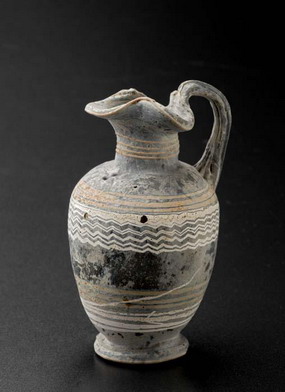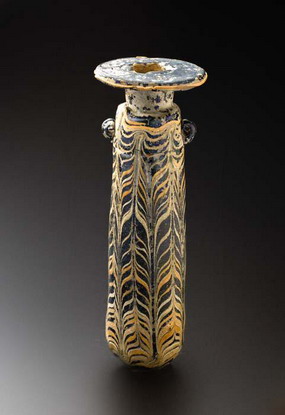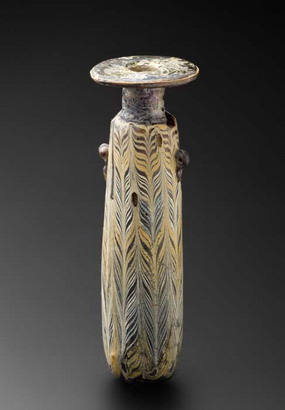第一章 古代玻璃器Ancient Glass
目前已知最早的玻璃出现在公元前5000年的美索不达米亚北部地区。在小型陶瓷器表面施玻璃釉料被认为是玻璃的最初形式。大约公元前1600 年,美索不达米亚、埃及和近东地区出现了纯玻璃器皿。最常见的类型是将玻璃丝缠绕在粘土或砂芯表面熔融制成。以硬核成形法为主要玻璃制造工艺。公元前1 世纪由腓尼基人发明的吹制技术,是玻璃发展史上的一个重要里程碑,从此人们能够制作出更大型、更精致的玻璃制品。在希腊化时期,亚历山大港和现在的叙利亚地区成为玻璃制造业的中心。在公元1 至2 世纪,玻璃工艺从这些地区广泛传播开来,远至罗马帝国的西部地区。
Ancient Glass
The earliest known glass was melted around 5000 B.C. in northern Mesopotamia. Vitreous glazes that coated the surfaces of small ceramic wares are regarded as the first glass objects. In c. 1600 B.C., all-glass hollowware appeared in Mesopotamia, Egypt and the Near East. The most common type was produced by winding glass filaments around a clay or sand core. Glassmaking techniques included core-formed glass. A crucial landmark in the history of glass, the invention of the blowpipe by the Phoenicians in the first century B.C. facilitated the production of larger and more sophisticated artefacts. In the Hellenistic period, Alexandria and the region of present-day Syria were the centres of glass manufacture. In the 1st and 2nd centuries A.D., the art of glassmaking spread from those areas further to the west within the Roman Empire.
1

酒壶
地中海地区(发现于卡普阿),公元前4-3世纪
不透明玻璃,饰有白、黄两色波纹;高11 cm
编号972
1886年购自美茵河畔法兰克福,L.&L.汉堡公司拍卖会
最初陶器中出现这种器形,后亦有玻璃或者金属的,通常特征为一个把手和三叶状嘴,用于储藏葡萄酒。这之后又出现了核式玻璃小酒壶,通过在沙核外缠绕彩色玻璃浆制成花纹。
Oenochoe
Mediterranean (found in Capua), 4th–3rd century B.C.
Opaque glass with combed decoration of white and yellow threads; H. 11 cm
Inv. no. 972
Purchased in 1886 at the L. & L. Hamburger Auction, Frankfurt am Main
Originally, oenochoe was a ceramic and later also metal pitcher with one handle and a trefoil mouth that served to store wine. Later on, miniature core-formed oenochoes were also made. The small bottle was produced using the technique of trailing – coiling coloured glass threads around the core and combing them to form a decorative pattern.
HB

2
长细颈瓶
地中海地区(发现于卡普阿),公元前4-3世纪
不透明玻璃,饰有白、黄两色波纹;高16 cm
编号968
1886年购自美茵河畔法兰克福,L.&L.汉堡公司拍卖会
这种长细颈瓶,瓶身小呈柱形,弧形底,用于盛放粉状物质。一般用雪花石膏制成(其原名“石膏瓶”就来源于此),但也有玻璃的。
Alabastron
Mediterranean (found in Capua), 4th–3rd century B.C.
Opaque glass with combed decoration of white and yellow threads; H. 16 cm
Inv. no. 968
Purchased in 1886 at the L. & L. Hamburger Auction, Frankfurt am Main
Alabastron is a small bottle with a cylindrical body and rounded bottom, used for storing powdery substances. It was typically made of alabaster (which gave it its name), but also of glass.
HB

3
长细颈瓶
地中海地区(发现于卡普阿),公元前4-3世纪
不透明玻璃,饰有白、黄两色波纹;高11.5 cm
编号970
1886年购自美茵河畔法兰克福,L.&L.汉堡公司拍卖会
Alabastron
Mediterranean (found in Capua), 4th–3rd century B.C.
Opaque glass with combed decoration of white and yellow threads; H. 11.5 cm
Inv. no. 970
Purchased in 1886 at the L. & L. Hamburger Auction, Frankfurt am Main
HB
| 